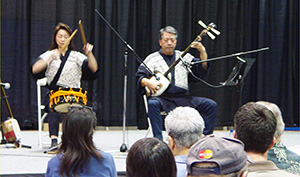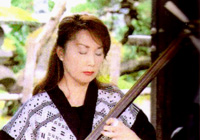| Back
to previous page |
~Past Event ~ 2006 Information |
Tsugaru
Shamisen Performers,
Hiroshi Matsuda (The Third Grand Master, Kida Rinshuei) accompanied by Kazuko Ota (Kida Rinka) |
| Mr.
Hiroshi Matsuda (his stage name: the third grand master Kida Rinshuei)
returned for a 2nd visit to the Aki Matsuri stage! Matsuda-san
performed at the 2004 Aki Matsuri, and both Matsuda-san and the matsuri
audience really enjoyed his performances. In 2006, he brought one of his top apprentices, Ms. Kazuko Ota (her stage name: Kida Rinka), and they conducted three (3) Tsugaru Shamisen performances on the stage in the Gym. |
|
|
| Mr. Hiroshi Matsuda - Profile |
(Photos
taken during 2004 Aki Matsuri) |
Mr. Hiroshi Matsuda was born in 1947 in Hokkaido, the northernmost island in Japan. After graduating from high school in Hokkaido, he moved to Aomori prefecture, the region and birthplace of Tsugaru Shamisen music, in the northern part of Japan's main island of Honshu. Matsuda-san started studying Tsugaru Shamisen 24 years ago as an apprentice of the first grand master of Kida Rinshuei and became the third grand master Kida Rinshuei in 1998. Currently he is teaching shamisen, and performing in many areas in Aomori. One of the unique sounds of playing Tsugaru Shamisen is improvisation like jazz music, which becomes a free interpretation of the sound. The player plays around original melodies and ad-libs around the music structure, in a sense that becomes more of a free style of the individual's sound. One of the unique styles of their playing is called tataki shamisen, which means using a large plectrum for striking and plucking the strings, similarly to a percussion beat, and playing melodies at the same time. |
Back to Top |
| Ms. Kazuko Ota - Profile |
| Ms. Kazuko Ota was born in Misawa-shi, Aomori. She begun practicing
Tsugaru Shamisen under Matsuda-san eleven years ago. She plays Tsugaru
Shamisen with Matsuda-san in many places. |
|
Back to Top |
| A Brief History Of Shamisen And Tsugaru Shamisen |
Traditional three-stringed plucked lute instruments called shamisen, and samisen music, were developed as a new instrument in Japan around the time of the sixteenth century through the nineteenth century, and mostly were played in the theater as an accompaniment rather than as a lead instrument. Tsugaru shamisen was developed among the Bosama, blind itinerant performers in the Tsugaru region, starting at the end of the Edo era approximately 120 years ago. Bosama entertained throughout the year, performing in small villages to which they traveled by foot. Tsugaru shamisen developed and eventually emerged as a solo instrument. |
| Hosting Provided by Pacific Software Publishing, Inc. Copyright © 1998-2015 ENMA |
Back
to Top
|
|

